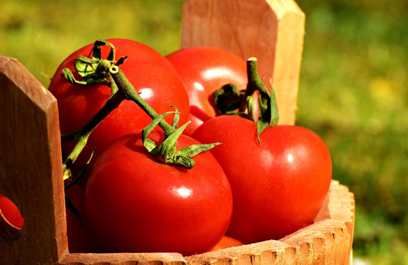Kilayim: Forbidden Mixtures

An abridged guide on the laws of kilayim, forbidden mixtures: kilei zera'im (interplanting seeds), kilei ilan (trees), and kilei kerem (vineyards). The parameters of each prohibition, the distance needed between types of seeds, and the application of kila'im outside of the Land of Israel, among others.
The verse in Vayikra (19:19) states:
אֶת חֻקֹּתַי תִּשְׁמֹרוּ בְּהֶמְתְּךָ לֹא תַרְבִּיעַ כִּלְאַיִם שָׂדְךָ לֹא תִזְרַע כִּלְאָיִם וּבֶגֶד כִּלְאַיִם שַׁעַטְנֵז לֹא יַעֲלֶה עָלֶיךָ
“Ye shall keep My statutes. Thou shalt not let thy cattle gender with a diverse kind; thou shalt not sow thy field with two kinds of seed; neither shall there come upon thee a garment of two kinds of stuff mingled together" (JPS trans.).
And in Devarim (22:9-11), it states:
;לֹא תִזְרַע כַּרְמְךָ כִּלְאָיִם פֶּן תִּקְדַּשׁ הַמְלֵאָה הַזֶּרַע אֲשֶׁר תִּזְרָע וּתְבוּאַת הַכָּרֶם; לֹא תַחֲרֹשׁ בְּשׁוֹר וּבַחֲמֹר יַחְדָּו
לֹא תִלְבַּשׁ שַׁעַטְנֵז צֶמֶר וּפִשְׁתִּים יַחְדָּו
“Thou shalt not sow thy vineyard with two kinds of seed; lest the fullness of the seed which thou hast sown be forfeited together with the increase of the vineyard. Thou shalt not plow with an ox and an ass together. Thou shalt not wear a mingled stuff, wool and linen together” (JPS trans.).
We see here that the Torah lists four different categories of kila’im, forbidden mixtures: (1) zera’im (seeds) (2) kerem (grapevines) (3) livestock (4) garments (sha’atnez). We will relate to the first two.
Kilei Zera'im - Forbidden Seed Mixtures
The prohibition of kilei zera’im is defined as planting in one area two different types of grains, legumes, or vegetables that are fit for human consumption. It is forbidden to grow two different types of crops in close proximity. The halachot pertaining to kilei zera’im are detailed by the Mishna in tractate kila’im.
The separation necessary between the crops depends on the size of the field and the type of seeds (a tefach is 8 cm, according to the opinion of Rabbi Chaim Na’eh):
Vegetables
- Between two rows or single crops of different types in the same vegetable garden: a distance of 1.5 tefachim (12 cm)
- Between two fields (where each field is 30x30 m): a distance of 6 tefachim (48 cm)
Grains
- Between two rows of grain or single crops of different types: a distance of 2 amot (96 cm)
- Between a row of grain and a row of vegetables, or between a single crop of grain and a single vegetable crop: a distance of 6 tefachim (48 cm)
- Between two fields of different types of grains, or between a field of grain and a field of vegetables: 10.2 amot (5x5m).
Legumes
- Between two rows or single crops of different types in the same area, between legumes and grains, or between legumes and vegetables: 6 tefachim (48 cm)
The prohibition against kilei zera’im applies only in the Land of Israel.
It is forbidden to leave a field of crops that have the status of kila’im.
A fruit that is the product of kilei zera’im may be consumed.
for more about kilei zera'im, see here.
Kilei ilan (grafting)
Kilei ilan is included in the prohibition of kilei zera’im
The Sages induced that grafting trees is also including in the prohibition of kilei zera’im. It is forbidden to graft a scion (shoot) of one tree onto the stock (trunk) of a different type of tree. However, it is permissible to graft a scion onto the trunk of a tree from the same family (for example, an orange onto a hushhash, a bitter orange). The prohibition also includes grafting a vegetable onto a tree, a tree onto a vegetable, and vegetables onto other vegetables.
It is forbidden to plant, water, or otherwise cultivate trees grafted in a forbidden manner. There are some poskim who permit cultivating grafted trees, however, when certain conditions are met.
A fruit that is created from grafting is permissible, however.
The prohibition of grafting trees also applies outside of Israel.
An etrog grafted in a forbidden manner is invalid and may not be used as one of the arbah minim on Sukkot.
It is permissible to plant seeds or saplings of different trees in the same area and in close proximity to one another. It is also permissible to plant trees (except for grapevine) next to vegetables, legumes, and grains.
Kilei Hakerem (Grapevines)
It is forbidden to plant a grape pit with two other types of seeds from grains, legumes, or vegetables; it is also forbidden to plant seeds of the above categories in close proximity to a grapevine.
The necessary distance from a single grape cluster is 6 tefachim (48 cm), and from a grapevine (5 grape clusters): 4 amot (192 cm).
If the grape is on a trellis, it is prohibited to plant grains or vegetables beneath the branches of the grapevine.
This prohibition only relates to plants that are used to produce food fit for human or animal consumption.
If planted in a prohibited fashion, the grapes and other plants are prohibited for consumption or benefit, as the verse states “פֶּן תִּקְדַּשׁ הַמְלֵאָה” “lest the fullness of the seed which thou hast sown be forfeited together with the increase of the vineyard,” and they must be burned.
If, however, there is a fence at least 80 cm high separating the grapevine from the other plants, this would not be considered kila’im, and the fruit is permitted. A deep ditch or tzurat hapetach (two poles with a string or board between them) also serve as a separation.
Kilei hakerem is a rabbinic prohibition outside of Israel.
While one may buy grapes in the marketplace since the majority is grown in a permissible fashion, it is always preferable to buy fruit and vegetables from a place with a kashrut certificate.
Forbidden grapes that mixed in with permitted grapes are nullified in a ratio of 1:200. Vegetables or grain that sprouted on their own in the vicinity of forbidden grapes also assume forbidden status and must be uprooted immediately.




